Travel
How To Visit The Colosseum, Roman Forum, Palatine Hill in Rome + Tips For Visiting
Rome, the Eternal City, is one of the most magical cities in Europe. It’s home to countless historical landmarks and architectural marvels, including one of the Seven Wonders of the World; the Colosseum.

This iconic landmark is one of the world’s most famous sites, so it’s essential to know how to visit the Colosseum and the nearby Roman Forum before you go, in order to get the most out of your visit and not get taken over by the crowds, which is what happened to us.
The Colosseum and the Roman Forum are two attractions that attract millions of visitors each year, so if you’re planning a trip to Rome and want to explore these ancient wonders, then here is all the information you need to tick these wonders off your to-do list.
Quick Booking Checklist
- Understanding the Colosseum and Roman Forum
- The Best Way To See The Colosseum and Roman Forum
- How we experienced the Colosseum and Roman Forum
- Things to See In The Colosseum
- Things To See At the Roman Forum and Palatine Hill
- Best Time to Visit The Colosseum and The Roman Forum
- Practical Tips for Visiting The Colosseum and Roman Forum
- Opening Hours and Fees
- FAQs About Visiting The Colosseum and The Roman Forum
- Final Thoughts
- More Rome Travel Tips
Understanding the Colosseum and Roman Forum
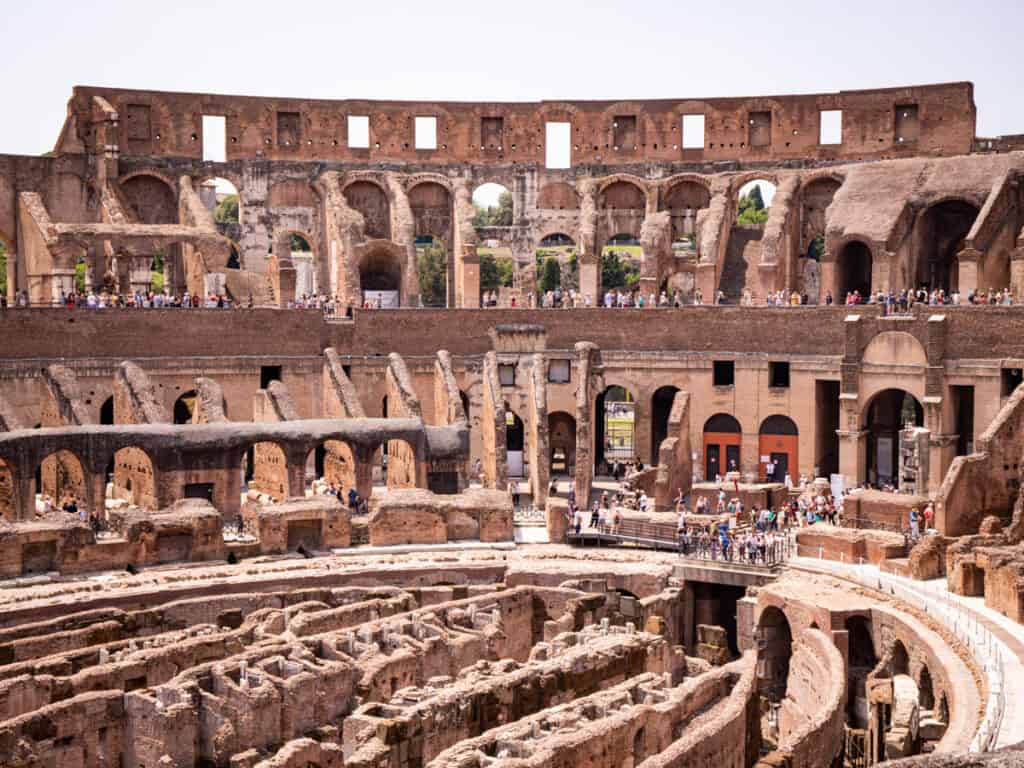
Before you go, it’s essential to understand the history and significance of these two sites.
The Colosseum, built in AD 70-80, is the largest amphitheater ever built. It was used for gladiatorial contests, public spectacles, and theatrical performances.
The Colosseum stands as a testament to the grandeur and architectural prowess of ancient Rome.
The Roman Forum, known as Forum Romanum, was the center of political, social, and economic life in ancient Rome. It started as a swampy valley between the prominent hills of the city.
Over time, it became a site for public meetings, law courts, and gladiatorial combats. Lined with shops and open-air markets, it buzzed with activity.
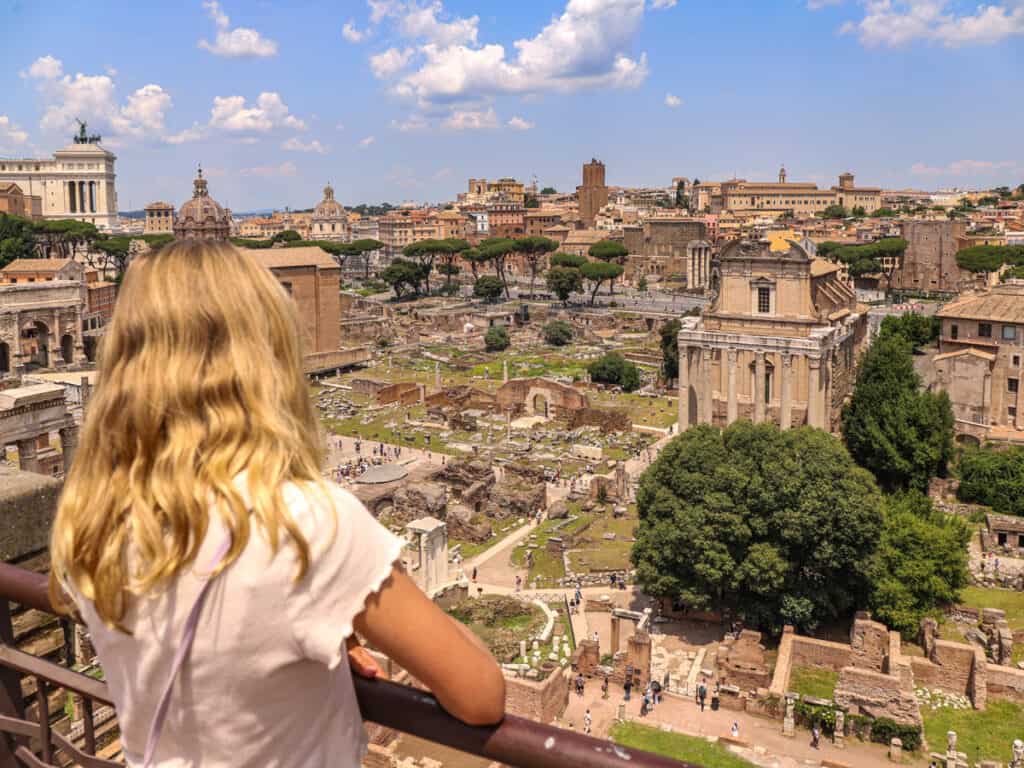
Now it buzzes with the activity of tourists walking about to learn a little about life thousands of years ago and marveling at the remains still standing.
Both the Colosseum and the Roman Forum were integral to the daily life and governance of the Roman Empire. Today, they are preserved as UNESCO World Heritage sites, allowing visitors to step into the past and appreciate the rich history of Rome.
Walking through ancient historical places like this always makes me wonder what they’d think if they knew people were enamored with their life thousands of years later. And what would people want to learn and see about our lives now thousands of years into the future?
I’m glad I live now rather than back then, but I’m not sure we have anything that can stand the eons of time like the ruins of ancient Rome!
It’s important to know that the Roman Forum and Palatine Hill are two different sites, but they are considered one area since they are next to each other. You’ll need to see both at the one time. Once you leave the area, you can’t come back in with your ticket.
All Colosseum tickets include entrance to the Roman Forum and Palatine Hill, which you can use either the same day or within 24 hours of the Colosseum Reservation time. You must arrive on time to the Colosseum.
The Best Way To See The Colosseum and Roman Forum

There are many ways to visit the Colosseum and Roman Forum, but whatever you do, do not simply rock up and join the queue for tickets. You will be waiting hours, and you won’t get the best out of your experience.
The best way to see The Colosseum and Roman Forum is by booking a guided tour. There is very little information about the history and significance of signage around the sites, so by simply purchasing an entrance ticket, you will miss out on a lot of the stories and history.
You should also book your tour tickets in advance so you can avoid the queues.
You can find tour guides outside the Colosseum who will likely approach you in the queue and ask if you want a tour, but they tend to charge a higher rate than what you find online.
Benefits of a Guided Tour of Rome
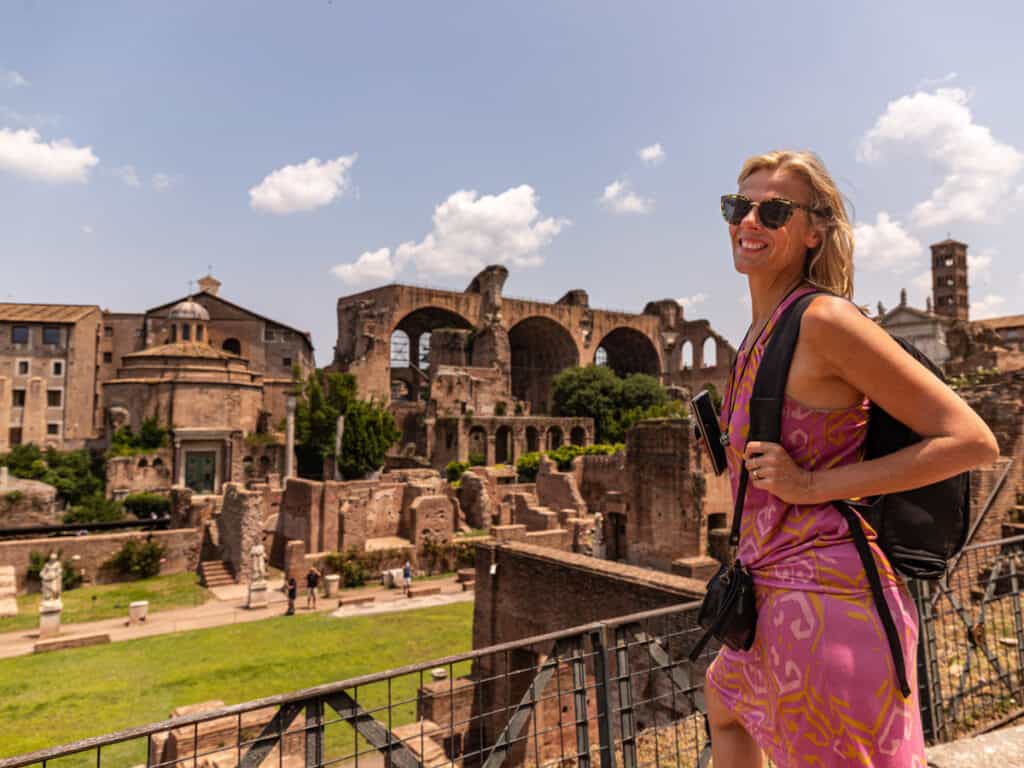
- Tour guides often have a separate entrance, which means you don’t have to queue for ages to purchase a ticket.
- You can learn about the history and stories of these two sites since there is little information available.
- Tours have access to areas the general tickets don’t allow you to go, so by booking a tour you won’t miss behind-the-scenes areas of the Colosseum and Roman Forum.
- Free cancellation up to 24 hours before the day of the tour, so you can change your mind at the last minute.
- There is also an option to do a Colosseum at Night tour or an Underground Colosseum Tour, which are not open to general admission ticket holders.
- They are only slightly more expensive than audio guides, but you get more insight and knowledge, plus the ability to ask questions.
The Guided Tour Companies we recommend for the Colosseum:
While in Italy, we experienced several small-group tours with Walks of Italy (also known as Take Walks) and LivTours for our guided tour of the Vatican. We loved both companies and recommend the following Colosseum tour with them.
How we experienced the Colosseum and Roman Forum
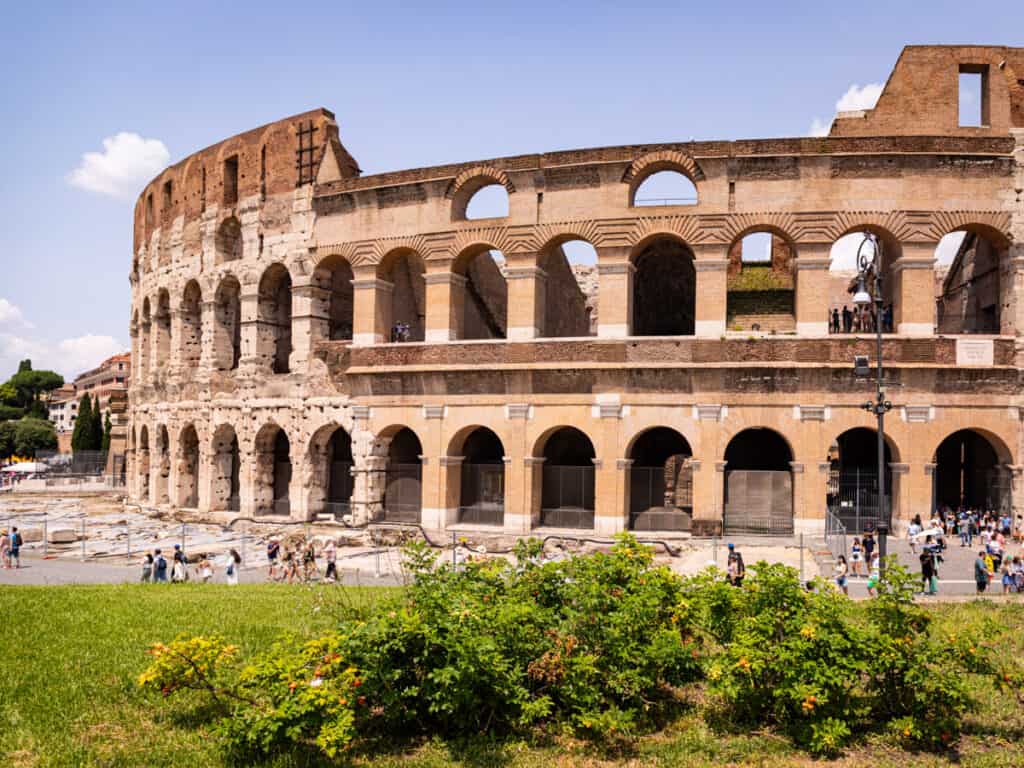
We had a Rome Go City Pass which included a ticket to the Colosseum and Roman Forum. Hindsight is a wonderful thing, especially for you, as you get to benefit from our mistakes.
This was the biggest mistake we made on our 4-week summer Europe trip. It meant we did not enjoy visiting the Colosseum, the Seventh Wonder of the World at all! In fact, it was the worst thing we did on our entire trip.
It shouldn’t have been that way, and many people have told us the Colosseum was their favorite thing to do in Rome.
While the Go City Rome Pass can save you money, the inclusion of the Colosseum on the pass is just an entry ticket.
The Roman Forum part of it was not too bad, as we had more space to roam about and take our time exploring. But, as mentioned before, information on what you’re looking at is quite scant.
When there was information, I enjoyed what I saw more. For example, the House of Vestals. Otherwise, it was just a bunch of ruins, albeit pretty ones.
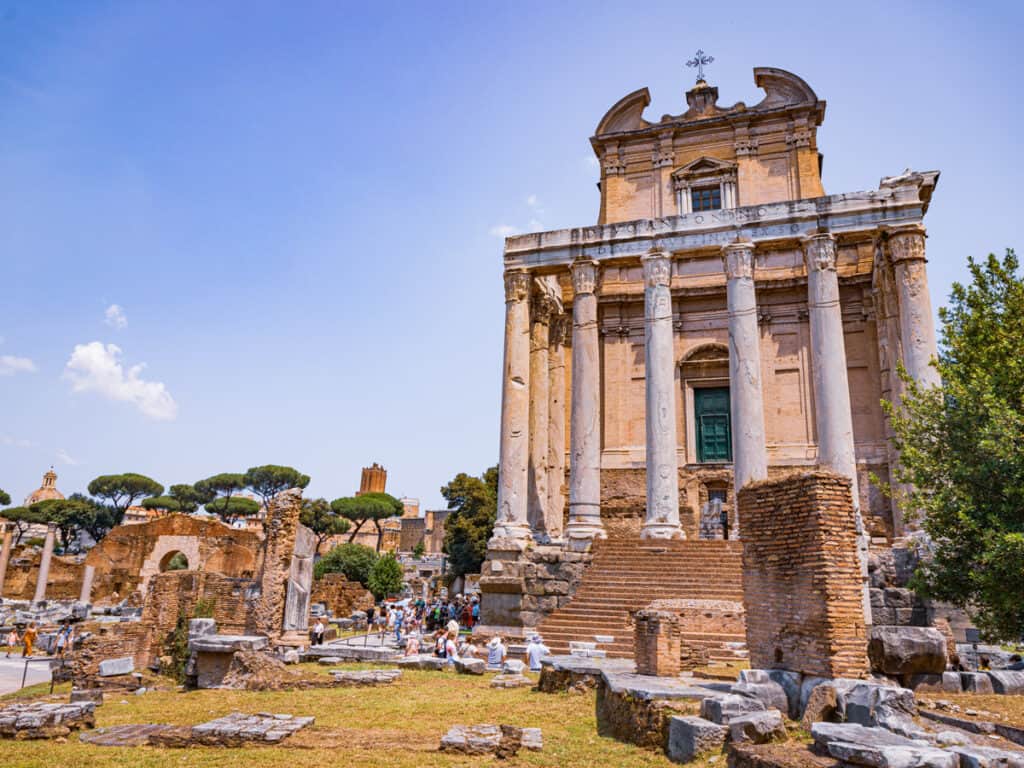
I really would have loved to learn more about this ancient civilization on a guided tour. I find it easier to connect and learn when I am on a tour, especially with kids. Because when we’re self-guided they will do everything in their power to distract me from reading and learning. A guided tour therefore also helps them connect and learn, as they’ll actually pay attention.
It was also quite confusing with the ticket for Ancient Rome through the Go City Attraction Pass.
- First you must book a tour time for the Colosseum. You must arrive on time, or they won’t let you in. You can then decide to visit the Roman Forum before or after it. We went before (allow at least 90 minutes) Once you leave the Roman Forum you can’t get back in so time it right.
- Then, you pick up your tickets at an office near Vittorio Emanuele II Monument. Leave yourself time as it was a chaotic mass of lines.
- Next, you meet a painfully slow chaperone who walks you over to the entrance to the Roman Forum to check you in. I have never walked so slowly in my entire life. She had to take us to the main ticket collector to prove our kids were kids.
- Now you’re free to roam around. There is a side gate taking you out of the Roman Forum and to the Colosseum when you’re finished.
That’s where the ultimate chaos started.
The crowds were so thick, it felt like we were leaving a Taylor Swift concert.
We did not know even know were on a one-way path through the Colosseum. We only realized once we were at the end. The attendants would not let us go back to see the parts we missed.
There was little signage explaining what we were seeing, or if there was, it was impossible to get to read. We were only in there for about 30 minutes, saw only half of it, and did not get to learn one thing about it.
We got to take photos from the outside, but it was still a very unsatisfying experience, and we were extremely disappointed.
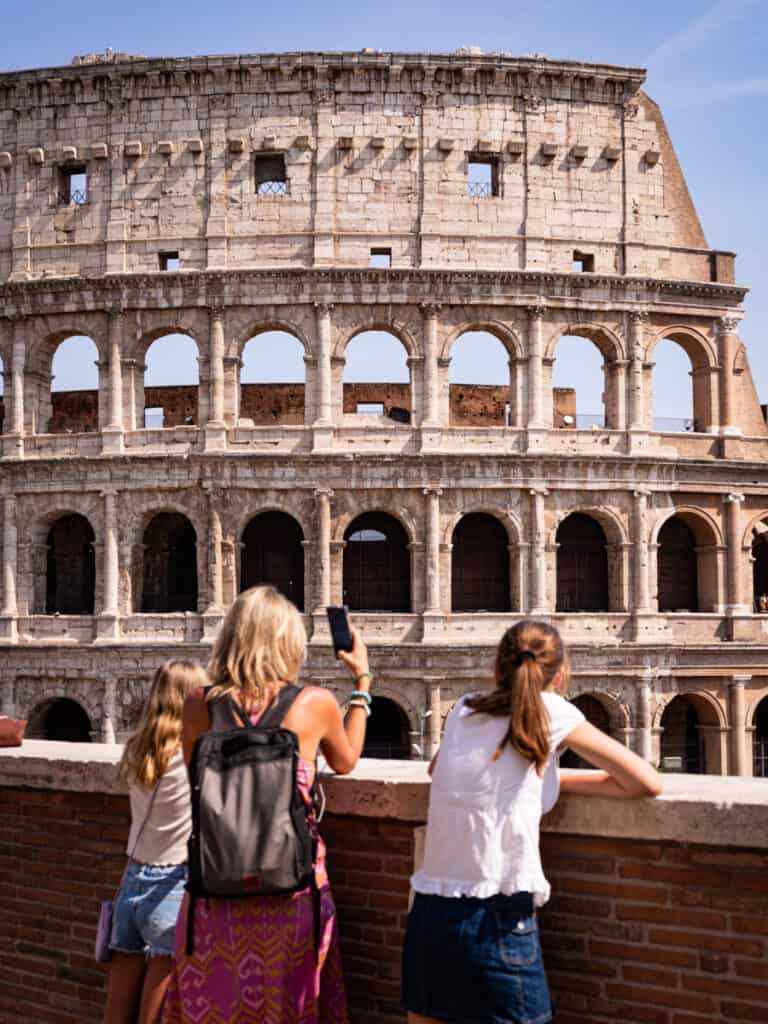
After we shared this with Instagram, many people told us the best way to see the Colosseum is on guided tour, one that goes early in the morning, and one that takes you onto the Arena floor and underground.
That’s why we saw people on the arena floor and couldn’t work out how to get there.
So now you know! We make mistakes to help you avoid them!
Now, you know the best way to see the Colosseum and Roman Forum, let’s look at what you can see in there (just in case you do it on your own!)
(As we missed most of these, we acquired the help from our editor to write about the parts we missed. She has visited!)
Things to See In The Colosseum
Below are some of the most unmissable things to see in the Colosseum and highlights not to miss.
Arena Floor
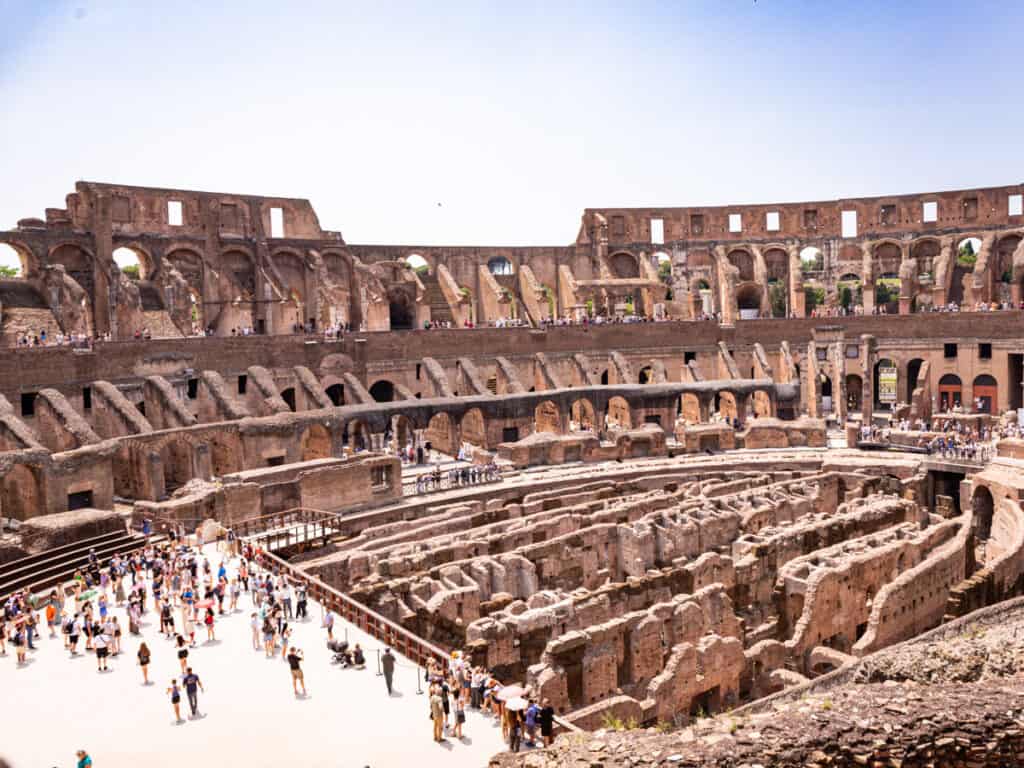
Stand where gladiators once fought and marvel at the magnitude of the stadium from the Arena Floor.
Stepping onto this historic stage transports you back in time to experience the grandeur and brutality of ancient Roman spectacles.
Walking on the same ground where gladiators once fought and entertained the crowds really helps to imagine the intensity of the battles and feel the energy that once filled the arena.
Only part of the arena floor has been rebuilt, allowing you to look down into the Underground chambers below.
You need a separate ticket to enter the Arena Floor area and the Underground Chambers.
Amphitheater Seating

Although the seating of the amphitheater no longer exists, you can still walk around the two tiers where seats once stood.
The second level is the best level, as you get better views of the Arena Floor and can also look out over the Roman Forum and Arch of Constantine. (This is the part we missed #weep)
Third Level (The Belvedere)
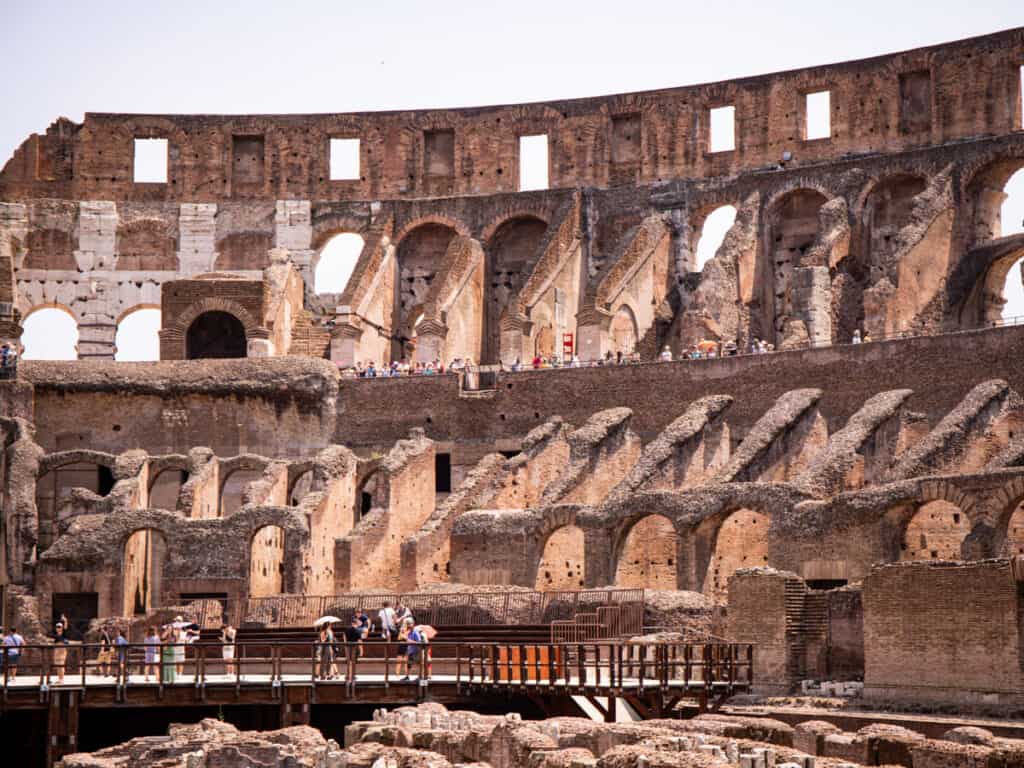
There is a third level of seating, known as The Belvedere, which is only accessible via guided tour.
Historically, this would be where the lower class would sit and is where you will find Roman toilets!
The Museum
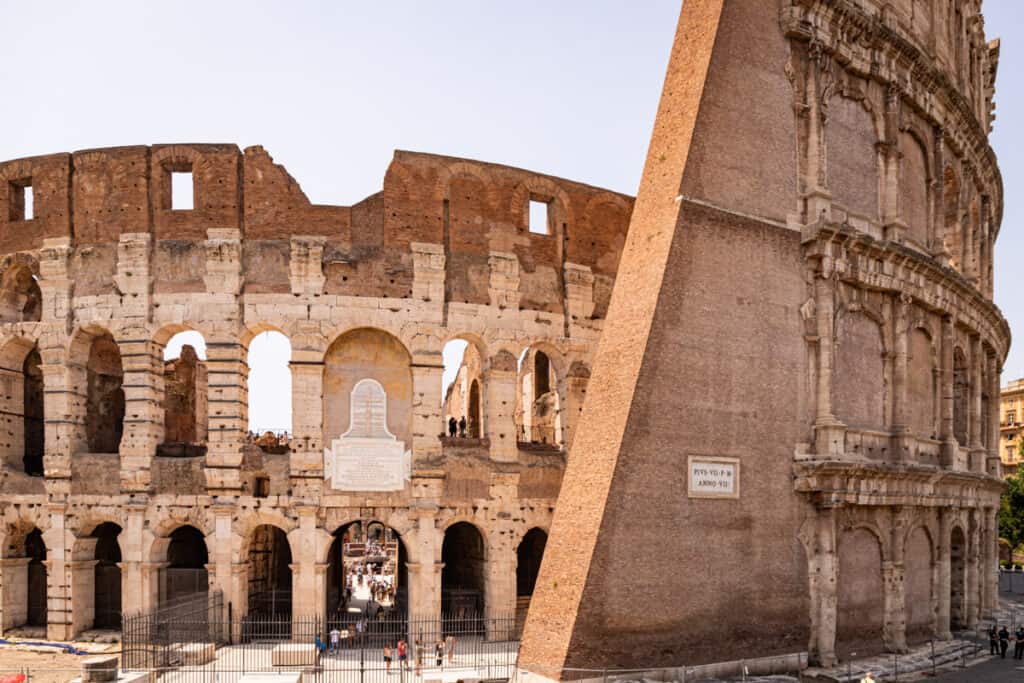
If you didn’t opt for the guided tour, be sure to check out the small museum on-site.
The museum has a handful of exhibitions that help visitors learn more about ancient Roman culture and daily life, as well as the construction and history of the Colosseum.
Yep, totally didn’t even know there was a museum!!
The Underground
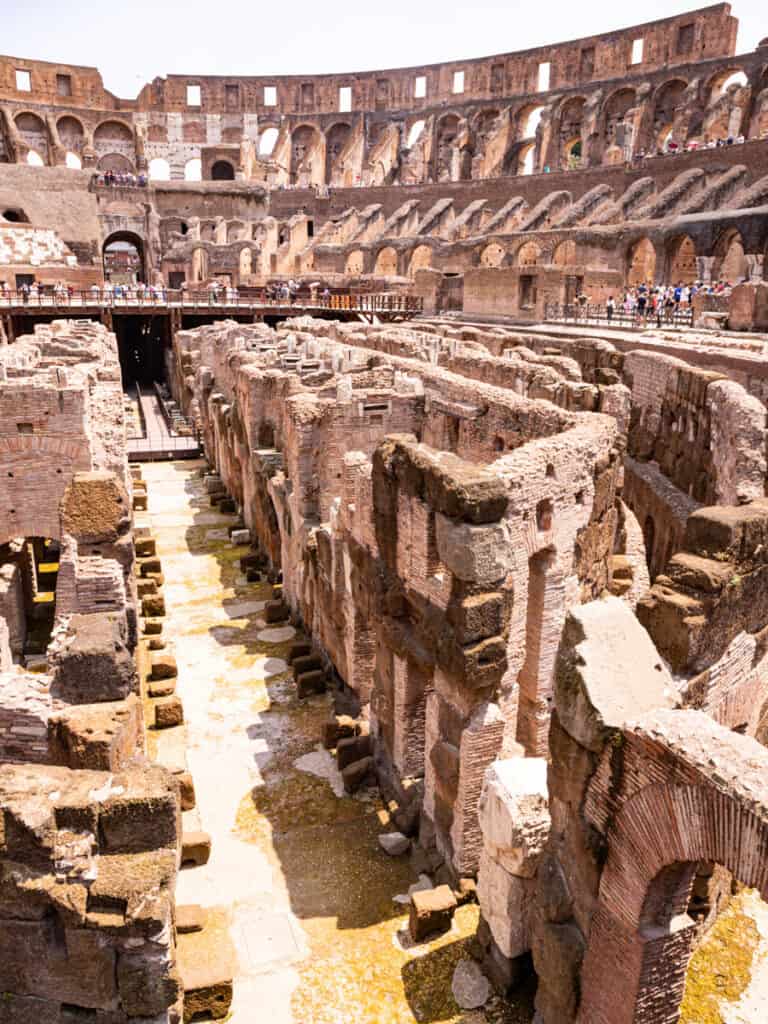
Beneath the arena floor lies a network of underground tunnels and chambers, also known as the hypogeum.
Exploring these hidden passages allows you to grasp the logistical and engineering marvels involved in staging events in the Colosseum.
See where lions were kept in cages and where gladiators warmed up before a fight. Although now in ruins, it’s still possible to make out rooms in this maze of tunnels and passages.
Like The Arena Floor, you need a separate ticket to see this area.
Arch of Constantine
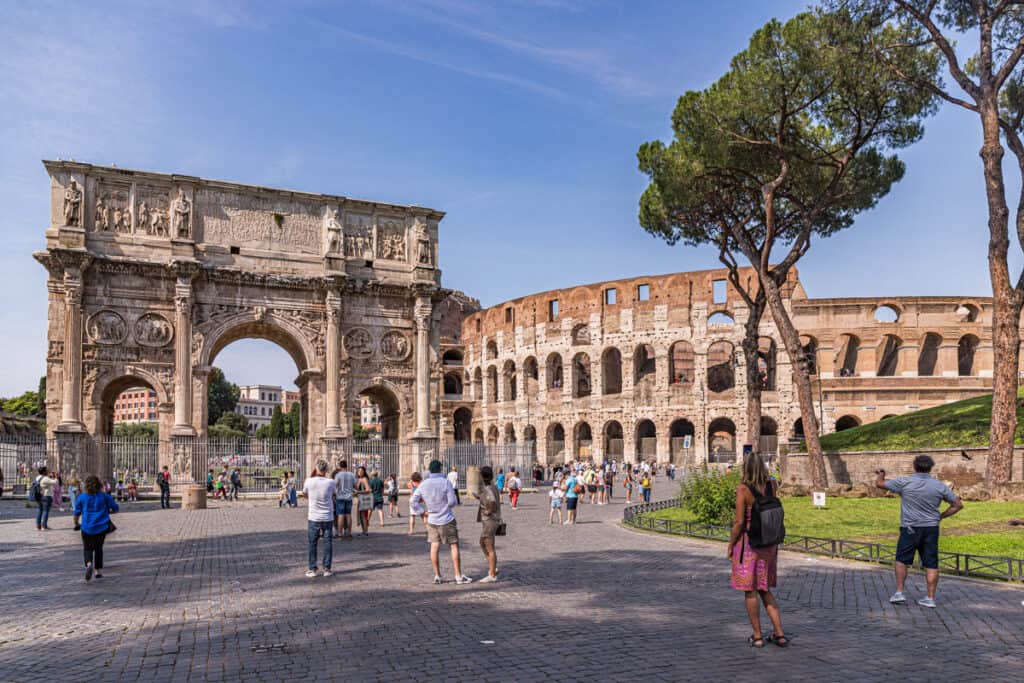
The Arch of Constantine, also known as Arco di Costantino in Italian, is a triumphal arch located opposite the Colosseum.
It was commissioned and dedicated to Emperor Constantine the Great. Built around 315 CE, the arch commemorates Constantine’s victory over the Roman tyrant Maxentius at the Battle of Milvian Bridge in 312 CE.
It’s the last and largest triumphal arch in Rome and is notable for its use of colored stone and decorative sculptures.
The arch stands as a symbol of the political achievements of Emperor Constantine and today visitors can admire its architectural grandeur and learn about the emperor’s triumph.
Things To See At the Roman Forum and Palatine Hill

We spent around 70 minutes in the Roman Forum and Palatine Hill. We did the Palatine Hill section last and I wish I had more time to explore this further. The views from here were gorgeous and I really liked the Farnese Gardens.
There were other garden areas at the back we completely missed!
While I know those beautiful ruins will distract you, don’t dismiss spending a few moments soaking up the beauty of the trees throughout the ruins.
In particular, in front of the Rostra Vetera (the elder Rostra), which was the large platform from which Roman senators delivered speeches and orations, three trees were considered to be particularly symbolic: the fig, olive, and vine. The ancient Romans believed these plants morally benefited the Roman people.
When visiting The Forum, make sure you check out the following landmarks…
Via dei Fori Imperiali
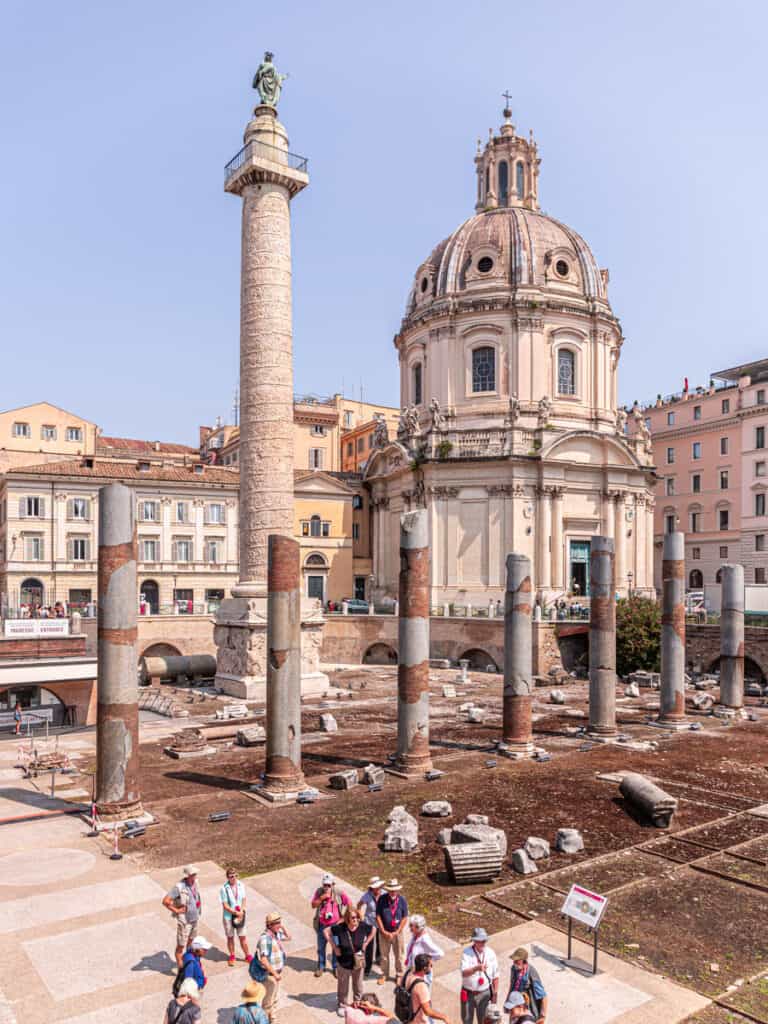
The Via dei Fori Imperiali is the main road that leads to the Roman Forum, connecting it with the Colosseum.
It stretches through parts of the Forum of Trajan and the Forum of Augustus, making it an integral part of the Roman Forum complex.
The road was constructed between 1924 and 1932 and underwent various name changes before being officially named Via dei Fori Imperiali (Road of the Imperial Forums).
This iconic boulevard is flanked by ancient ruins on both sides, providing a captivating glimpse into the grandeur of ancient Rome.
The archaeological area of the Imperial Fora can be explored by crossing a footbridge on the site.
Important Temples

The Roman Forum is home to several remarkable temples that showcase the religious and architectural prowess of ancient Rome. Be sure to check out the following temples:
- Temple of Castor and Pollux: Built in 494 BC, this temple was dedicated to the divine twin brothers Castor and Pollux, known as the Dioscuri or twins of Gemini (twin sons of Zeus and Leda). It served as a gathering place for political and religious activities.
- Temple of Saturn: Dating back to 501 BC, this temple was dedicated to Saturn, the god of agriculture and wealth. It housed the state treasury and important documents.
- Temple of Vesta: The oldest temple in the Roman Forum, dating back to the 7th century BC, it was dedicated to Vesta, the goddess of the hearth. It served as the sacred dwelling place for the Vestal Virgins, one of Rome’s most ancient and important cults.
- The Temple of Julius Caesar: built in 42 BC, and was built by his adoptive son, Octavian, and is said to be built on the site of his cremation.
- The Temple of Antoninus and Faustina: It was constructed in 141 AD by Emperor Antoninus Pius in honor of his deceased wife, Faustina the Elder, but was re-dedicated to both Antoninus and Faustina after his death. It was turning into a Roman Catholic Church.
- The Temple of Romulus: although the history of this temple is still under debate, it’s believed that it was dedicated to Jupiter by the founder of Rome, Romulus. It’s famous for its ornate green bronze door and circular shape.
The Curia Julia

The Curia Julia is a historically significant structure that served as the meeting place for the Roman Senate.
Built in 44 BC by Julius Caesar, the Curia Julia replaced the previous Curia Hostilia, which had been destroyed by fire.
The construction of the new Senate House was completed under Augustus Caesar’s rule. The Curia Julia was an important site where senators discussed and debated matters of state.
Today, visitors to the Roman Forum can marvel at the remains of the Curia Julia. Although it underwent several modifications over the centuries, it still retains its original architectural features.
The exterior facade showcases Corinthian columns and intricate details, while the interior houses a grand hall with marble floors and remnants of wall decorations.
The Column of Phocas
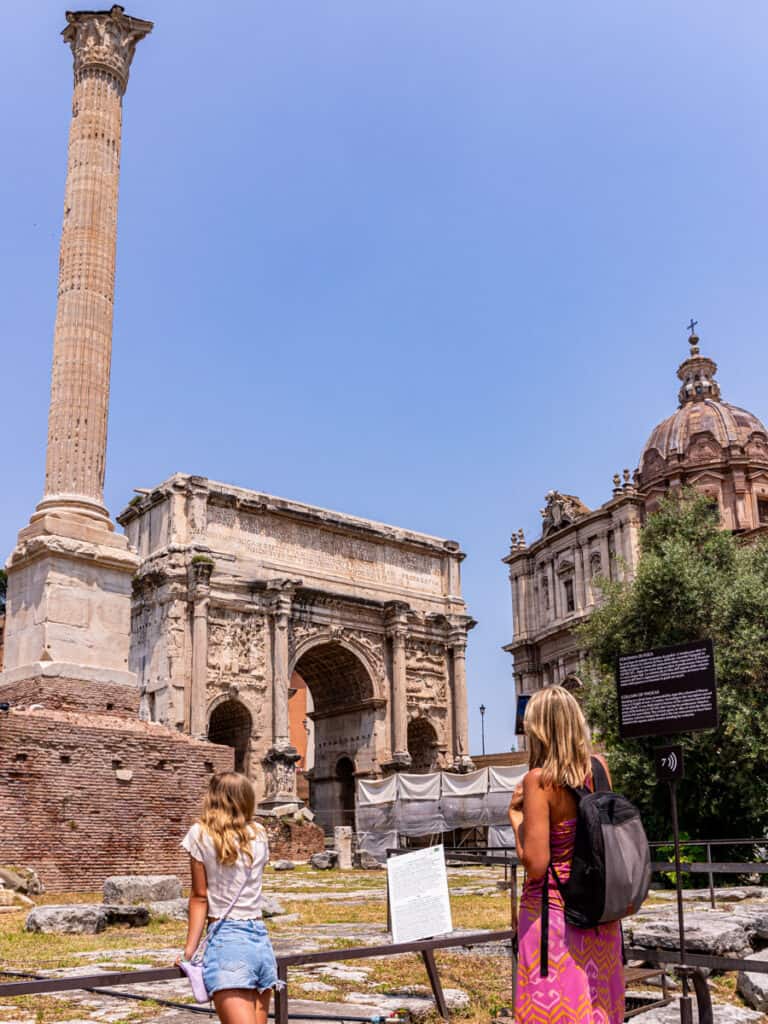
The Column of Phocas is a monumental column in the Roman Forum and was the last monument to be built in the forum. The column was erected during the Middle Ages when Italy was under the rule of the Goths.
The Column of Phocas stands on a brick base surrounded by marble steps and reaches a height of 13 meters (over 40 feet).
It was dedicated to the Eastern Roman Emperor Phocas and features an inscription on its pedestal. The gilded statue that once adorned the top of the column is no longer present.
The Via Sacra

The Via Sacra, meaning “Sacred Way,” was the main street of ancient Rome and holds immense historical significance.
It stretched from the top of the Capitoline Hill and passed through the heart of the Roman Forum, connecting several important religious and political sites. This iconic road served as a center of commerce, everyday life, and religious processions.
Walking along the Via Sacra today showcases the rich history of ancient Rome. The cobblestone path takes you past noteworthy attractions, including the Arch of Titus, the Temple of Vesta, and the Curia Julia.
The Basilica of Maxentius

The Basilica of Maxentius, also known as the Basilica Nova, was a grand secular basilica in the Forum.
It was once the largest building in the Forum and the last Roman basilica built in the city.
Commissioned by Emperor Maxentius and completed in 312 CE, it was intended to showcase his power and authority.
The Basilica of Maxentius was an architectural marvel, featuring massive columns, soaring vaulted ceilings, and intricate decorative elements. Despite its partial ruin, visitors can still appreciate the grandeur and scale of this once awe-inspiring structure.
Arch of Titus & Arch of Septimius Severus

The Arch of Titus and the Arch of Septimius Severus are two iconic structures in the Roman Forum that hold significant historical and architectural value.
The Arch of Titus, constructed in the 1st century AD, stands on the Via Sacra in Rome. It was built to honor the victories of Emperor Titus, including the siege and destruction of Jerusalem. Look on the inside of the arch to see sculptured scenes from the conquest.
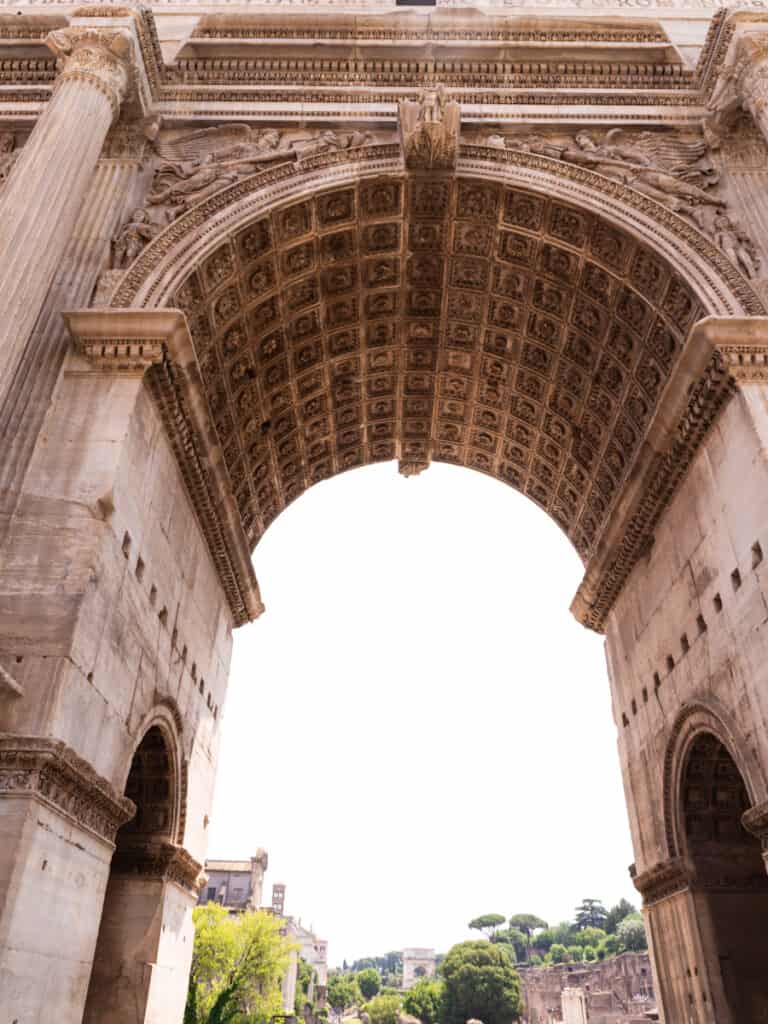

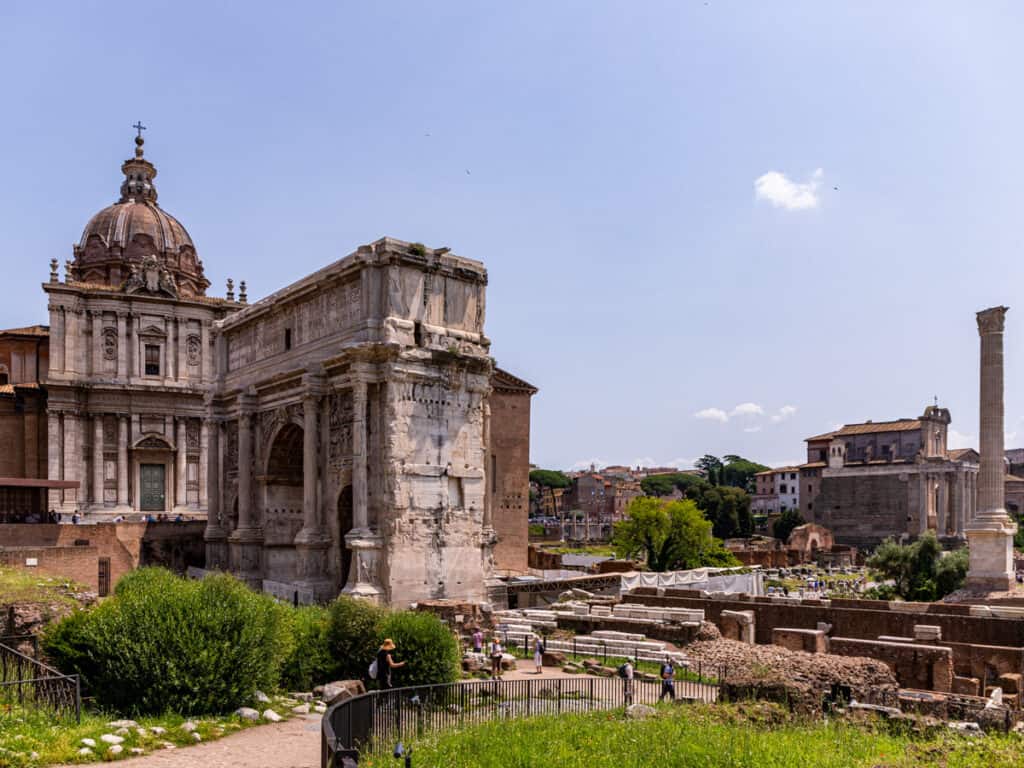
The Arch of Septimius Severus was erected in the early 3rd century AD. The arch commemorates the military campaigns of Emperor Septimius Severus and his sons, Caracalla and Geta.
House of the Vestals

The House of the Vestals, located behind the circular Temple of Vesta at the eastern edge of the Roman Forum, was the residence of the Vestal Virgins.
The House of the Vestals, also known as the Atrium Vestae, was an important and sacred place in ancient Rome.
The priestesses had to be young aristocratic virgins and were chosen by the Pontifex Maximus when they were between six and ten.
While the role of a Vestal Virgin brought great wealth and privilege it did require chastity and the observation of strict rituals like keeping alight the public fire that burned in the Temple of Vesta and celebrating annual festivals.

It was quite the contemplation walking around the remains for seemed to be quite a peaceful and pretty courtyard.
Built around 113 AD, during the reign of Emperor Trajan, the House of the Vestals consisted of various rooms where the Vestal Virgins lived and performed their religious duties.
Palatine Hill
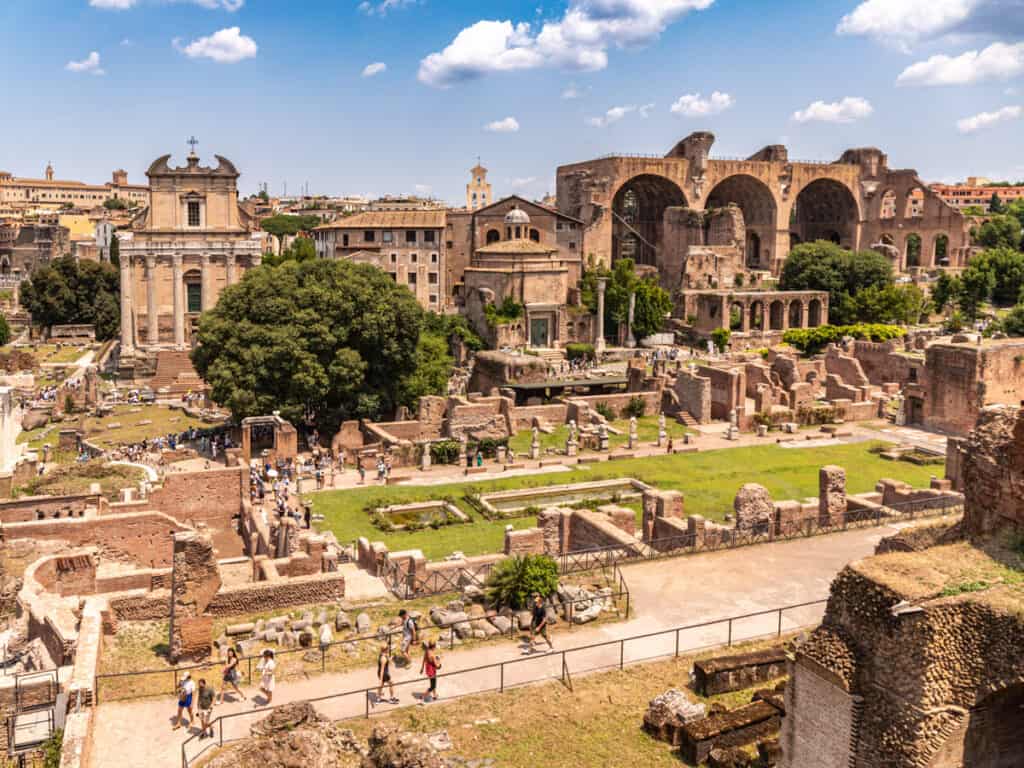
Palatine Hill, one of the seven hills of Rome, holds a significant place in history as the legendary birthplace of the city.
It is in the same archaeological area as the Roman Forum with views over the ruins and landmarks. The views here were some of my favorite.
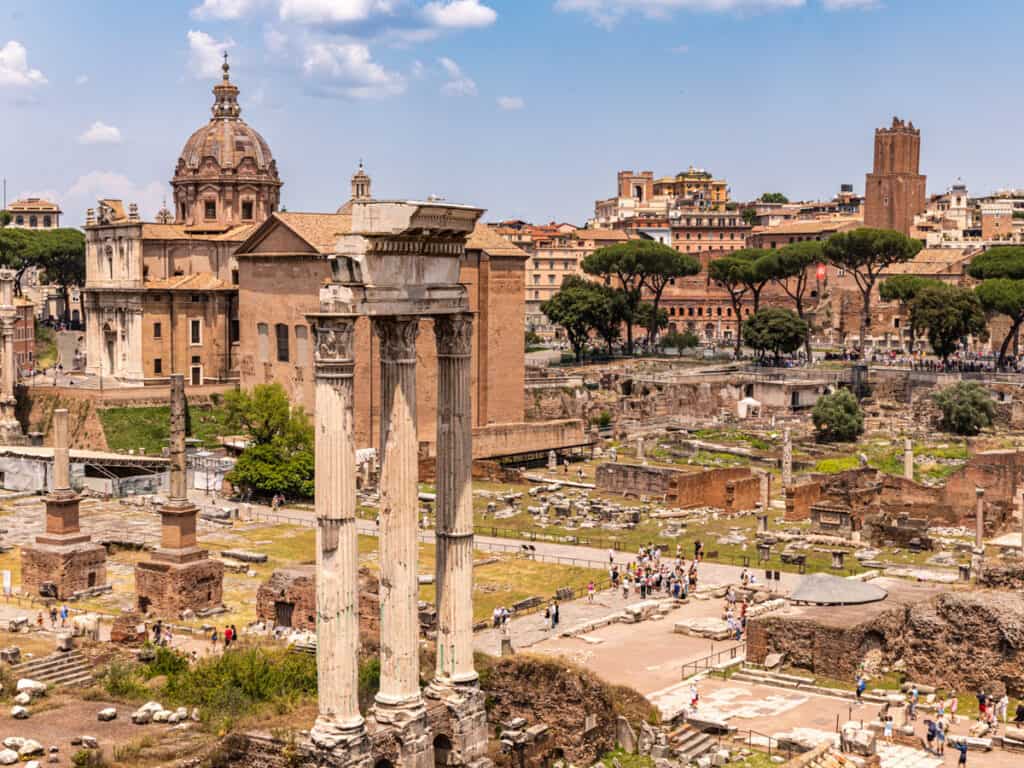
With a history dating back to the 10th century BC, Palatine Hill was once home to emperors, aristocrats, and wealthy Romans, and you can still see the remains of these palaces on the hill today.
Farnese Gardens

I was disappointed we walked upon the Farnese Gardens right before we were due to leave in order to make our Colosseum entry time.
They were quite beautiful with lush greenery, blooming flowers and beautiful sculptures along panoramic terraces.
Visitors can also explore the Farnese Gardens on the hill, which are adorned with lush greenery and beautiful sculptures.
Best Time to Visit The Colosseum and The Roman Forum
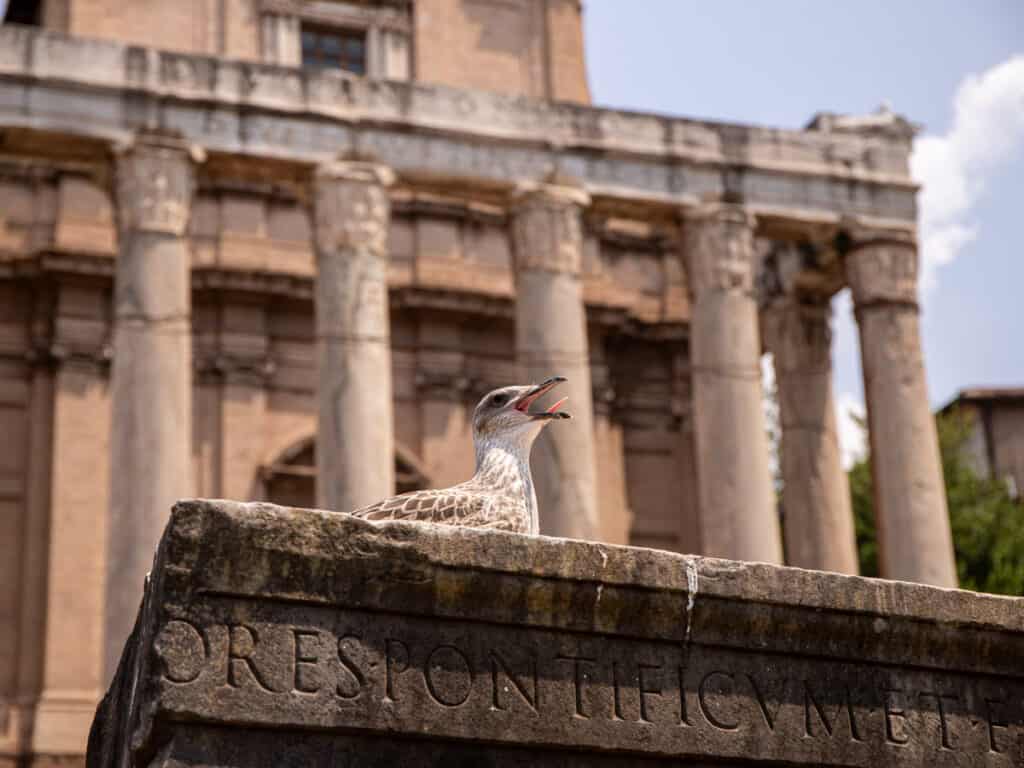
It goes without saying that early morning or late afternoon are the best times to visit to avoid crowds, but it’s also to avoid the stifling midday heat.
If you’re not set on visiting at a particular time of year, consider planning your trip for the shoulder seasons in Rome, which fall in Spring (April-May) and autumn (September-October). These months offer pleasant weather and fewer tourists (though be aware there will still be some tourists!).
You may also want to visit on the first Sunday of the month when entrance is FREE. You can expect long queues on that day since no online reservation is available.
Practical Tips for Visiting The Colosseum and Roman Forum
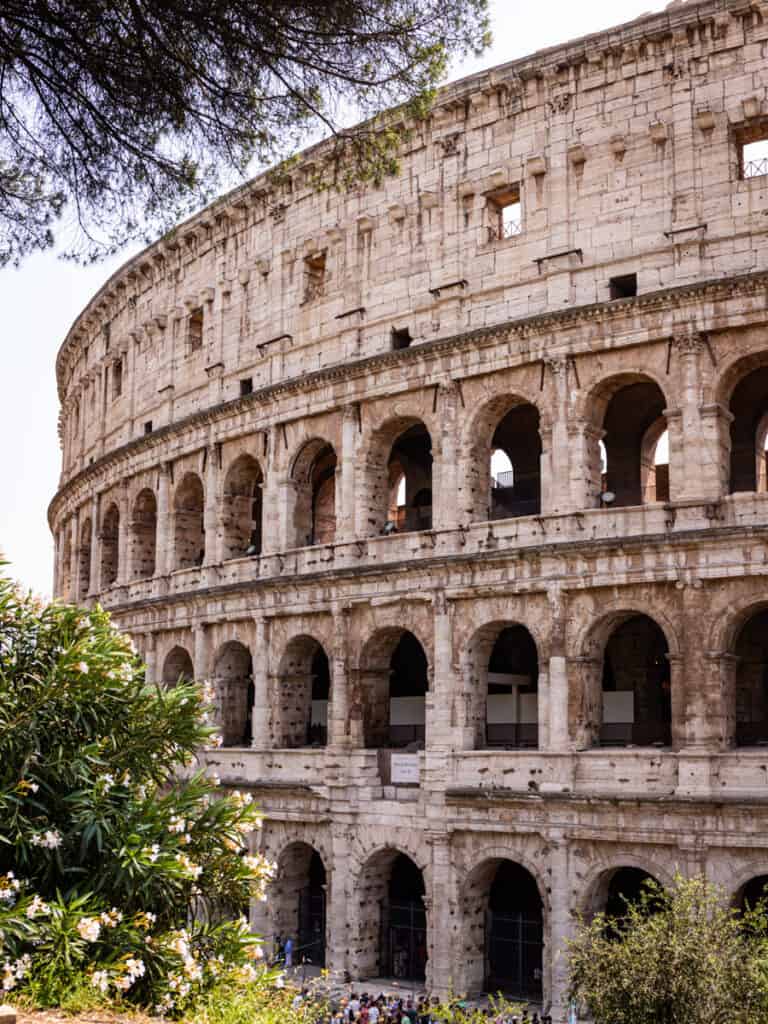
Before you go, here are some words of advice to make your visit run smoother…
- Wear comfortable clothing. Wear comfortable shoes and dress in layers, as exploring these sites requires considerable walking and can be hot in the summer months.
- Bring lots of water and wear sun protection. Carry a water bottle and wear sunscreen, especially during the summer months.
- Follow security guidelines and be prepared for bag checks at the entrances.
- Leave large luggage at your hotel. You can only bring in a small backpack and large cases and bags will not be allowed in.
- Respect photography rules and be mindful of not disturbing other visitors.
Opening Hours and Fees
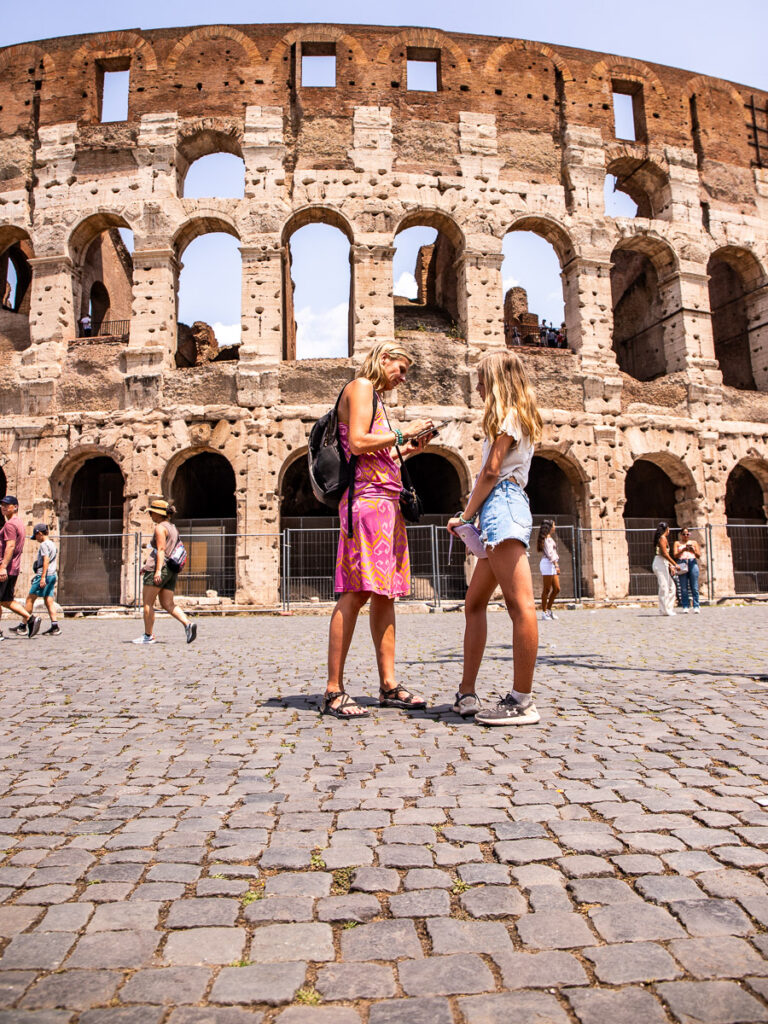
Standard admission tickets include access to the Colosseum, Roman Forum, and Palatine Hill.
There is also an option to purchase a ticket that’s valid for two consecutive days if you are short on time. This is an additional €6.
The ticket options are as follows:
- Priority/Skip-the-Line Tickets Purchased in Advance: €16 for adults, €6 for children 0-17, €24 for an audio guide and adult ticket, €12 for a child ticket and audio guide.
- Full Experience including the Arena Floor and Underground: €22 for adults.
- Guided Tour Tickets – It’s recommended to book tickets in advance to secure your preferred time slot.
- Roma Pass – this is an attraction pass that allows you skip-the-line access to 1 or 2 of a selection of many of Rome’s top attractions
There are also discounted tickets for EU citizens aged between 18-25 and for those with disabilities or students.
Opening hours are as follows:
- 9.00am – 4.30pm, Jan 1 – Feb 28
- 9.00am – 5.30pm, Mar 1 – Mar 26
- 9.00am – 7.15pm, Mar 27 – Aug 31
- 9.00am – 7.00pm, Sep 1 – Sep 30
- 9.00am – 6.30pm, Oct 1 – Oct 30
- 9.00am – 4.30pm, Oct 31 – Dec 31
You can purchase tickets from the official website. Note, that during busy season, it will be hard to find availibility. But, that doesn’t mean you have to miss out. Another benefit of joiningg in a guided tour, is that they pre-purchase tickets, which means you’re IN!
Remember, that a guided tour will give you the best experience in significant historical sites like this, especially with those maddening crowds. While we think Get Your Guide is a great platform for booking tickets and tours, we like to recommend booking directly with LivTours and Walks of Italy, as we know like and trust them through personal experience. We just don’t know what tour company you’ll get via Get Your Guide (although usually they are fine!).
FAQs About Visiting The Colosseum and The Roman Forum

How long do you need for the Colosseum and Roman Forum?
The recommended amount of time for visiting The Colosseum and the Roman Forum is 3 hours, but honestly, you could spend 4-5 hours exploring both sites and make it more leisurely. Most guided tours are around 2.5-3 hours.
Is it better to see The Forum or Colosseum first?
Since you can purchase a combined ticket for the Colosseum and The Roman Forum together, you can decide which attraction you want to see first. Most people tend to visit the Colosseum and then visit The Forum after, as the Colosseum doesn’t take as long to see.
However, you can only visit The Forum and Palatine Hill once and the Colosseum ticket is valid for a specified time, so you might want to visit The Forum first if you are visiting the Colosseum later in the day.
Final Thoughts
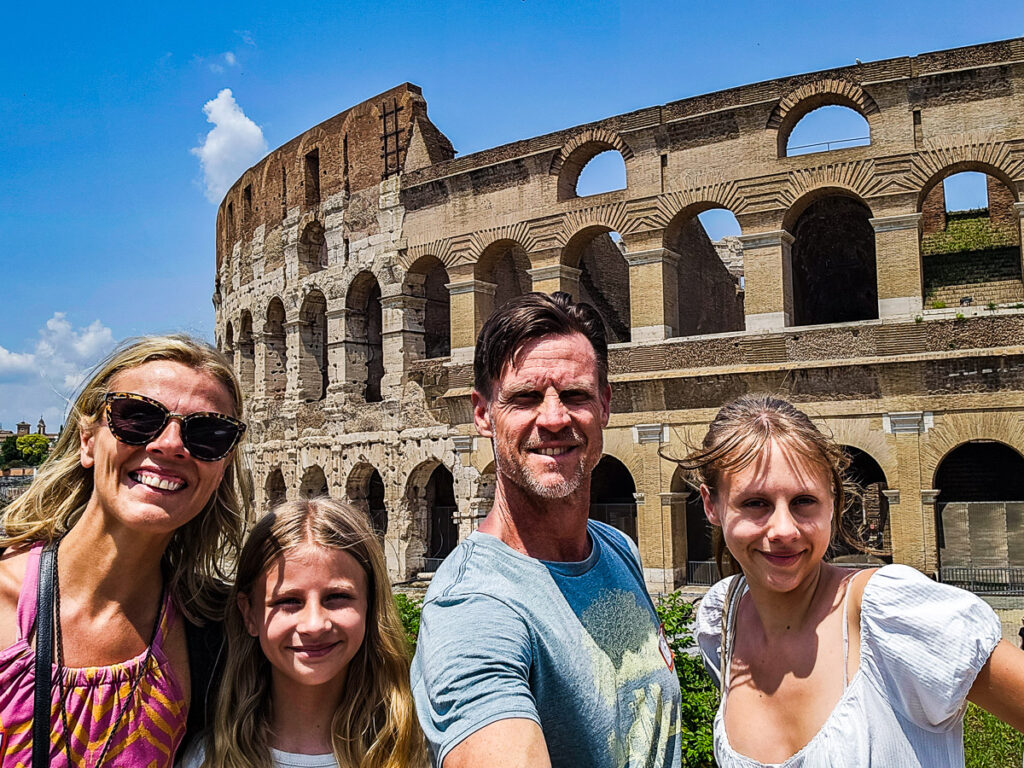
Visiting the Colosseum and Roman Forum is a journey through the rich history of ancient Rome.
Immerse yourself in the grandeur of the Colosseum and explore the remnants of the once-thriving Roman Forum, gaining a deeper appreciation for the ancient world and its enduring legacy.
By following the tips and suggestions provided in this guide, you can make the most out of your visit to these remarkable landmarks. I can’t recommend enough to at least do the guided tour of the Colosseum. It was the biggest mistake of our Europe trip.
A place that ancient, magnificent and significant needs to be properly experienced and understood.
We hope this guide helped you plan your trip to the Colosseum and Roman Forum, and we hope you enjoy and savor the experience of walking in the footsteps of ancient Romans.

